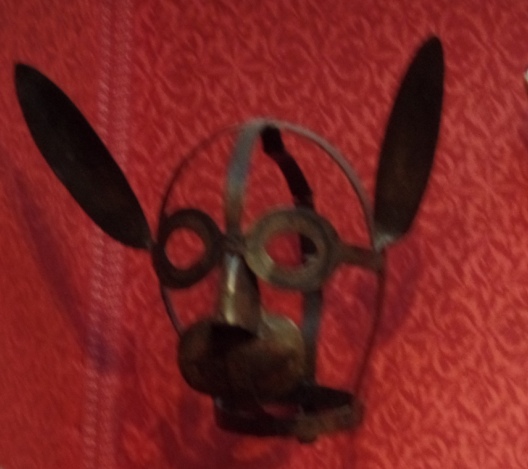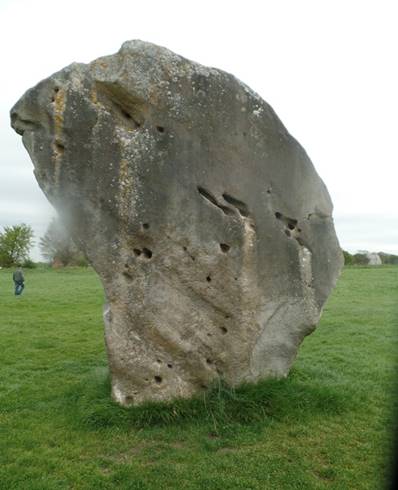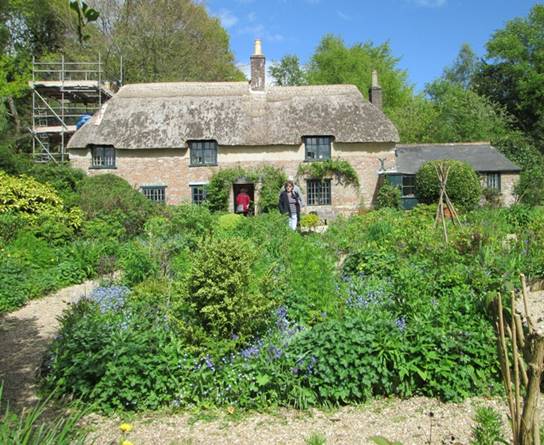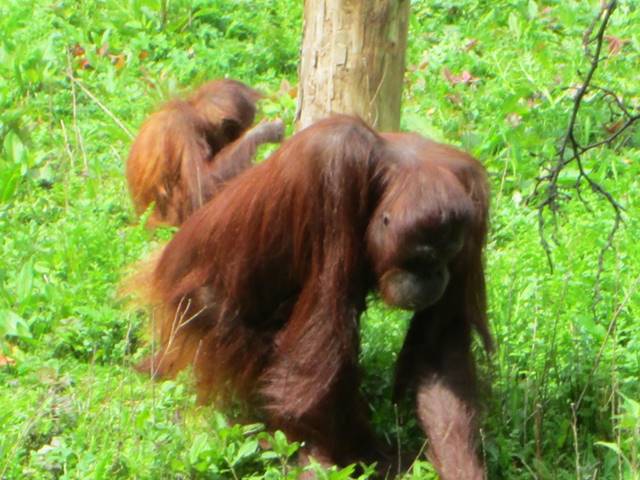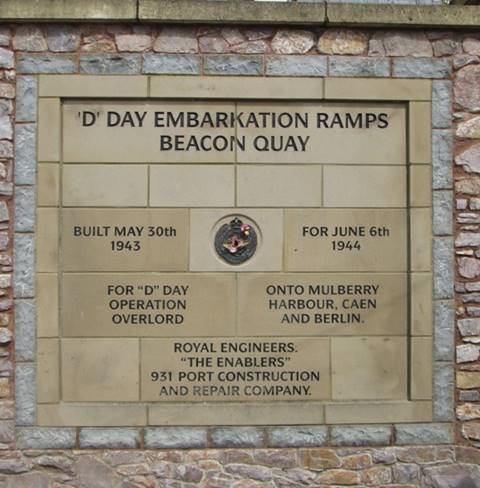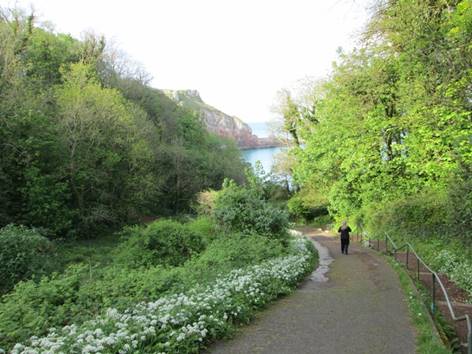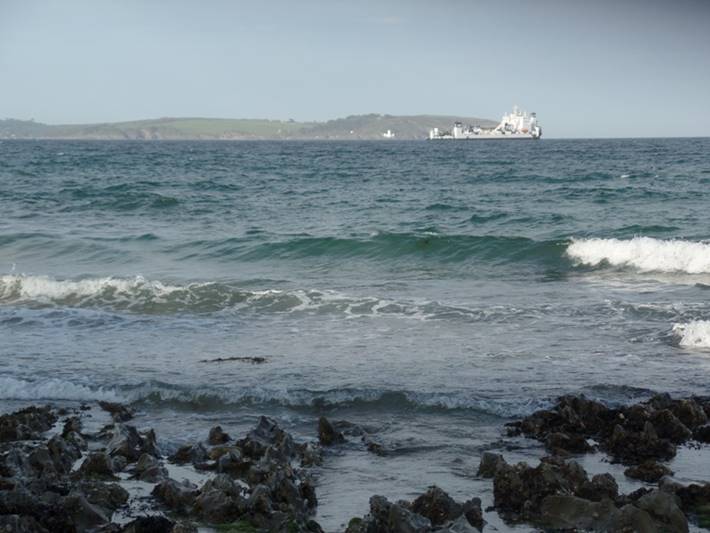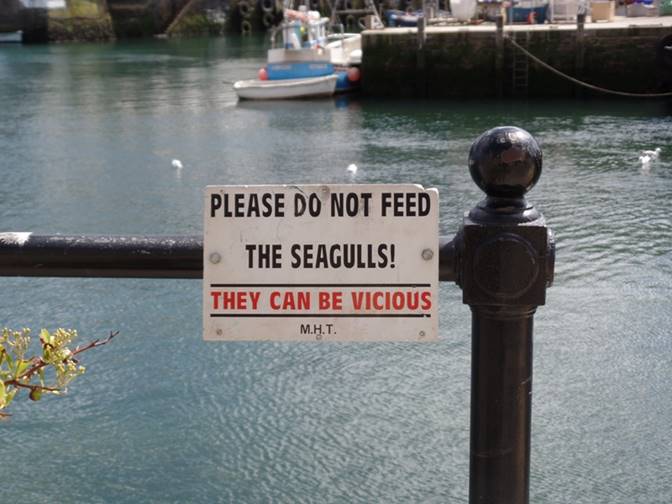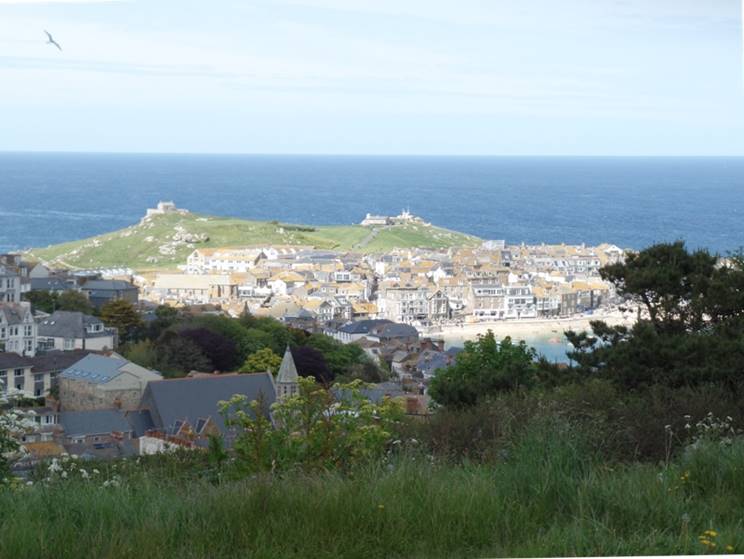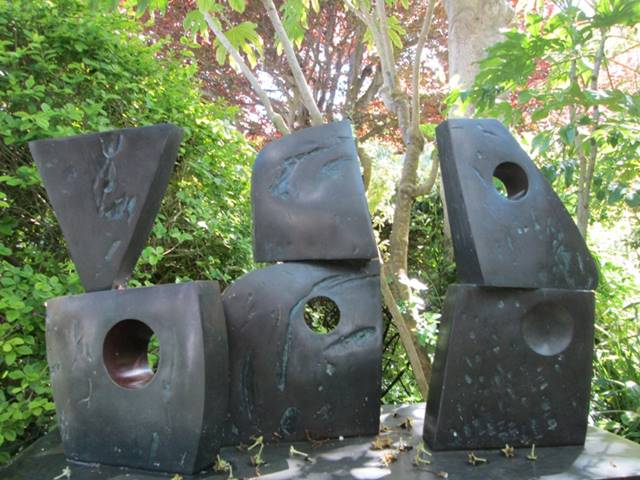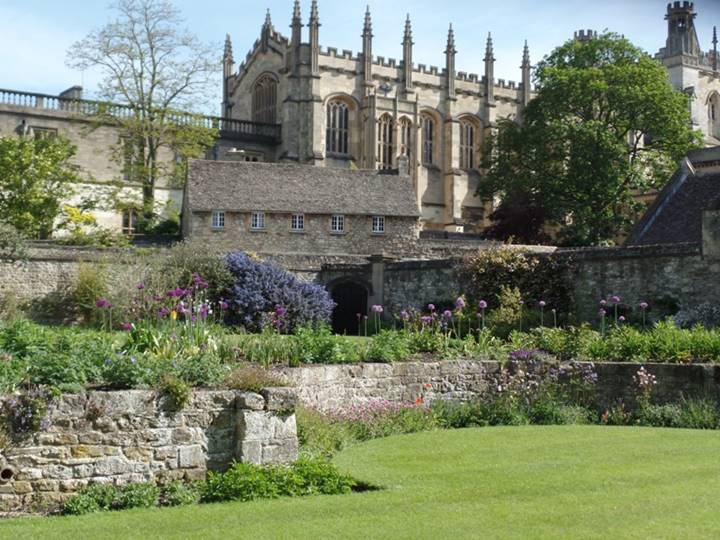Alan Catlin
Nothing quite says a trip to England as a four hundred page book, read on the plane over, war torn Europe as Hell (WW II) by Philip Kerr called, Lady from Zagreb, on the eve of the 70th anniversary of VE Day.
Day 1
Trip begins with tour bus trip to Crown Plaza Hotel near JFK; redolent of bathroom
sanitizer. Read massive headache inducing scent.Decided to stretch our legs after long bus trip in residential Queens neighborhood near the clutch of overnight hotels just the other side of the Van Wyck from JFK. Mostly well-kept, modest homes, punctuated by phantasmagoric array of metal fencing and majestic, palatial gates. It has been a while since I’ve seen elephant fence ornaments, majestic concrete lions, kissing birds, Art Deco iron with a, suggestive-of-natural-wood gate, with trimmed flowering, almost Zen in appearance, tree beyond.
Ungodly departure time of 5:30 with luggage in lobby looms.
Unanswered question: why no cold water from taps in hotel?
Day 2
Ungodly hour comes and goes and we are still sleeping. But not for long as ringing room phone can only mean One thing: Oh, shit!
We are dressed, shirt buttons askew, packed and in the lobby in record time. Can honestly say that when we boarded the fully loaded bus to officially begin our vacation, everyone was so glad to see us they gave us an ovation.
Uneventful flight. First destination is the exquisite Great Fosters Hotel. The use of the word exquisite is not an exaggeration, as the word was invented there during the reign of Henry VIII, who once stayed there. The hotel was designated as Grade 1 building for good reason, as you could almost hear the theme from the original Masterpiece Theatre as you either tripped over the raised doorway, or, hit your head on the low entranceway. (I tripped.) People were much shorter in Henry VIII’s time. Half expected to see Alistair Cooke at reception but he couldn’t make it.
Elegant Tudor dining room with exposed beams embossed with regency symbols. You find your eyes drawn up and all around this restored period space complete with fireplace in full blaze. You don’t even feel compelled to ask where Henry slept and which wife he was working in at the time of his shooting party here.
Our suite, complete with squeaky warped floorboards, and a fascinating array of wall hangings, ranging from nude pen and ink sketches to complicated battle scenes, is the Duke of Wellington Room. Even the books are meant to be held and read; they are definitely Not chosen for period ornamentation because of their bindings. But actual books: twelve, mostly Romantic poets, in red bindings on a side table near a reading lamp and comfortable chair. If I wasn’t half-asleep, I would have read some Shelley or Keats. Instead, we decided to check the TV for Brit pre-election day predictions, which had Labor leading by thirteen points and a major upheaval in the making on election day. There can be no question that the British six weeks of campaigning and political blathering, is far superior to our endless campaigning which does little but annoy, antagonize and, eventually, stupefy, a mostly recalcitrant and uninterested public. Why do we go on as we do? Unlimited money. And jobs, jobs, jobs for pundits, talking heads, and know-it-alls, who once, in a moment of rare honesty, said it usually boils down to a couple of swing districts in South West Ohio and all the rest is stuff and nonsense. And lots of money spent on TV time. And so on. God Bless America!
As we settle in for the night, there is the occasional airplane heard in the distance headed for Heathrow. Much more pleasant than Royal Crown Plaza and the incessant hum of traffic on the Van Wyck.
Day 3
Awoke to a view from diamond paned window of sculpted topiary garden with a small arched bridge over a pond reminiscent of Monet. The clinging, hanging wisteria, just coming into bloom, heightens the effect. Within the master garden, are smaller, color themes gardens such as the blue and yellow one. We are told, by fellow travelers, that guided tours by an attentive, knowledgeable garden cat are available.
In MemoriamIn the blue hedge
garden behind GreatFoster’s Hotel: iris
in bloom, columbine,forget me nots. In secluded
corner, lichen stainedwhite headstone
with fading inscriptionindicates, here lies
beloved sheep dogmany years gone
Today we are on the road to Waddesdon Manor, a Rothschild pile that shows what you can do with unlimited capital and questionable taste confusing ostentation with quality.
Sights along the country roads:
Egham News and Booze
How do you know you are not in America: Road Work
We apologize for any inconvenienceAlternative Tools
Junk & Disorderly
The Cod Father
Pass through Cookham, home of eccentric artist of the apocalypse: Stanley Spencer.
Also residence of Jerome K. Jerome, author of one of the enduring comic classics of all time: Three Men in Boat.
Pass the forest and home of children’s author Kenneth Grahame who wrote the immortal Wind in the Willows. Back story of the tale is tragic, as not only was the marriage that produced the son he wrote the book for and about, but later, the young adult son was a suicide by railway train.
Raymond Chandler might have aptly described Waddesdon along the lines of: You might not have been able to play a full court basketball game in the main dining room, but you could have had a decent square dance there, no problem, or a fair sized lobster quadrille, if no one came to call the dance, with room left over for a good game of freeze tag for all the kiddies in the first form.
Waddesdon is a place so huge and stuffed with well, stuff, you can only imagine the discussion between architect and patriarch, that resulted in an addition of a huge wing because, “there just isn’t enough room”. Apparently Sir Joshua Reynolds was the house artist on permanent retainer, in case of the pressing need for an emergency portrait of family member or visiting dignitary. The Gainsborough of a Mrs. Robinson, was intriguing as the flush faced, severe looking lady hardly conjured up images of Anne Bancroft in heat, but nonetheless, was compelling enough to make one speculate about her hidden, inner life. Still, it was difficult to imagine any kind of sordid affair in Waddesdon or anything even remotely tawdry except, maybe, in the men’s smoking lounge in the upper floor.
Passing Through Cookham on a NE Road
Painted white storefront:
Fernlea, Cookham, site
of English eccentric artist
Stanley Spencer known for
roaming town and cultivating
extreme oddness wherever he
went, both in speech and manner.
Now, decades later, Spencer’s
notions are mostly conferred
to canvas and graveyards
that form the substance of
his art. Cookham road, outside
his gallery, so narrow, pedestrians
roam at their own risk, perilously
near bumper to bumper traffic:
Spenserian spirits are subsumed by
gasoline exhaust and diesel fumes.
In his day, townspeople were
accustomed to being used
indiscriminately, without permission,
for artist’s wild vision quests:
days of judgment, grave openings,
rapture moments, end time soirees
like some “They Came Back”
existential movie or perverse
Norman Rockwell study, through
a looking glass, he might have
titled, “Apocalypse Now! on
Cookham Streets” with unwelcome
ambient traffic noise as film
score.Last Night at Great Fosters
Acres of yellow rape seed
in full bloom like someVan Gogh landscape
with unnatural blue skyand red kites instead
of crows.
Election returns are in: polls incredibly wrong. All the forecasts incorrect. Refreshing end of the day even if it was a conservative win. A newspaper headline reads: Five More Damned Years.
Day 4
Return to Avebury, larger, ore dispersed site than more famous Stonehenge with its self-contained stones and lintels. Avebury is much larger circle though many stones had been removed and used by settlers for various constructions purposes including roads and houses. Others buried stones have been unearthed and preserved. We had been here previously, just before the summer solstice in ’01, and did not take the guided walking tour as we did this time around. This time we missed the New Age whackos, latter day Druids, and general human freakdom that migrated to nearby Stonehenge on the date of reckoning (the solstice) when sun and stone meet in perfect harmony and the celebration of seasonal rebirth can began anew. It had a genial, spaced out, return to the 60’s, kind of peace and love and orgy now! feel to it, then, though none of the behavior would ever be confused with normal…..
This time the affable and extremely knowledgeable National Trust guide conducted us among the general excrescences of “service” sheep and other grazing animals, used to keep the grass trimmed. He issued a general caution, in addition to his historical recitation, that for liability reasons, we cross the roadway at our own risk and not follow him because he might be suicidal. Which, of course, we all did.
In addition to the fascinating history of the reclamation and archeological discoveries on the site, the guide offered a theory about the ditch and mounds surrounding the stones. The way they are placed, the mounds on the far side of the ditches and the stones in the interior, suggested they were not for military purposes but to keep the spirits represented by the stones inside.
Leaving Avebury, we saw Silbury Hill, largest manmade hill in Europe, and also recalled our previous visit and climb up to West Kennet Long Barrow where one of the UFOligsts, prevalent everywhere around solstice end times, thought I was an alien because I was wearing a hearing aid and was, presumably, communicating with alien space ships due to land at any moment. Apparently both hills have a strong magnetic pull and are known conductors of weirdness that attracts all manner of unidentifiable flying objects and the people who believe in them.
Overheard at dinner: “If you think the Avebury fields were bad, you should have been with us on our past trip. I was cleaning penguin shit out of my boots for a year but it was worth it.” I wondered where that was……….
How do you know you are not in America #2: In Dorchester: “Polite Notice: No Parking in This Area”
Day 5
Also spotted in Dorchester a sign that could be taken the wrong way: “We like children for breakfast and luncheon.”Interesting piece of literary trivia gathered from a recent reading Olivia Laing’s account of walking tour of the river Ouse following in the tracks of Virginia Woolf. Leonard Woolf’s rule to live by was originally “Nothing matters,” later amended to “Nothing matters, everything matters”; Woolf channeling Beckett. Who knew?
Off to Stourhead, a landscape garden on an immense estate. It was created for sightlines of buildings, ponds and grottos, during different seasons, more than a particular flowering of plants and trees. The principal color in May is variants of green, in the trees, which the guide assured us became much less varied later in the season. One can only guess what it looks like in lush Fall colors. Still, it is impossible to ignore the vision and work to achieve these remarkable sightlines for a pantheon, folly, grottos and a temple that figures prominently in the Keira Knightly “Pride and Prejudice.” We did not have time to see the house or walled gardens, which is why we feel compelled to buy National Trust books whenever we go to one of their sites whether we have the time to explore it properly or not.
The code to live by on a trip like this is: Enjoy what you can. You can’t regret what you don’t have time to see.
Bracing walk for some considerable distance up and down hills and the like much appreciated after several days of spending way too much time sitting on means of conveyance.
Afternoon visit to Hardy’s cottage. Another hike down a long country road too narrow for a bus and without proper parking. The cottage was where he wrote his first three novels including his first big success, Far From the Madding Crowd. The cottage is a smallish, unassuming dwelling, unable to accommodate more than eight people at a time upstairs, where his writing studio was. Though cramped inside, for so many visitors, the main room is warm and cozy and seems unaltered since its description in Return of the Native. A functional, working kitchen and a modest library at the base of stairs that lead to the second floor where there is a sewing room, a bedroom and the author’s studio. Among the clutter of period art and objects an oddment that could only be described as stuffed squirrels behind glass. As room guide aptly said, “Well, that’s the Victorians for you. If it stopped moving, they stuffed it and made a tableau out of it.” It was doubtful this piece was an actual Hardy relic.
From the studio window you can see a blue garden in bloom. One has to imagine the lush profusion of roses on the trellis outside the main entrance that would bloom in a few weeks. We opted for the rambling forest path back to the road and could easily imagine Hardy walking here as he gathered his thoughts in between bouts at the writing table.
Return of the Native
The view from Hardy’s cottage studio
window is impaired by an encroachment
of trees: a profusion of bird calls within,
fields of blue bells, white wild flowers.
Is a place for contemplation, exercise
walks between pages of Under the Greenwood
Tree, or Far From the Madding Crowd,
which could have been the title for a book
about how much he detested London
but isn’t, per se. Mood indigo and pale
blue the feeling now, in mid-May,
more appropriate for Wessex Tales and poems
than the most depressing novels ever written:
Tess and Jude the Obscure: all those doomed
heroes and heroines, whose modest wishes were
for a simpler, better, moderately happy
life , better than the one they were living.
Were ruthlessly denied happiness,
their fates unequivocal, final, through
no faults of their own, leaving them cursed,
cast out, banished for all times, bodies buried
in one place, their hearts in another like
the creator who fostered them.
Day 6
Even mentally prepared for the idea of the English Riviera, actually seeing palm trees, experiencing the balmy weather, with a hint of the tropics, is another. The place we are staying is called The Palace Hotel and has that kind of weathered, slightly derelict, not-quite-up-to- form, charm of a place that has known better days. No doubt the heyday was in the 20’s after the war and before the crash. and you could almost expect to see Scott and Zelda and the Murphys , maybe even Hem and Hadley and/or Pauline, for dinner and drinks.
On the agenda is a visit to Dame Agatha’s “modest” summer home which she acquired for a song and six thousand pounds. The place and view are instantly recognizable to fans of the Hercule Poirot series, as it was the setting for the final episode on the PBS Masterpiece Mystery series. Touring the immaculately preserved, extremely cluttered, in an organized, very livable way, home, the six thousand pound sum seems mind boggling, no matter when it was paid and whatever the exchange rate was. Agatha knew a bargain when she saw one and the people who care for the home obviously take great pride in keeping the place and the grounds up. Agatha and her husband, Max, the archeologist, were great collectors and as they traveled far and wide, the tokens and keepsakes they acquired are diverse and fascinating, indicating a life filled with explorations and enchantment. The ground are also full of small surprises featuring several walled gardens, a tennis court almost entirely engulfed by massive rhododendron and a hidden fountain high above the greenhouses. If this is a seasonal dwelling, never used as a permanent residence, one wonders what the main domicile was like.
Poem Written to Images Suggested by a Book Read
on a Coach in EnglandOnce inside the bared bird cage
of her mind, she invents dialogues
for an array of species acting as
a Greek chorus in a tragic play
written by someone like Euripides,
who was fluent in languages that
transcend speech and the static
order of beasts.The protagonist she envisions
is played by death with black masks
that represent different stages of
existence in the journey downward
after life into a new place there is
no known name for yet.
She has a comic role to play
as a hand maiden to the various
Gods of the Underworld, though
her most important role is a foil
to a hero’s wife who remained faithful
to her man while he was wandering other
world just beyond the outskirts of
Elysian Fields.When it came time for her spoken
lines, her voice sounds as if it were
trained by a speech coach who doubles
as a Fury making each word a torment
to everyone who listens, most of all
the woman who is trapped in a cage
embracing Death as if he were
a lover she might one day escape.
Day 7:
“I’ve been to the zoo”
No, not the Edward Albee play, but the Paignton Zoo. Another amazing English landmark founded by, who else? a wealthy English eccentric, just before WWI. Besides being a truly Humanitarian collection where, as much as possible, the environment of the animals are replicated. As the climate is much more moderate than most of England, it is possible to cultivate vegetation here that would not be possible elsewhere in the country. You can see gibbons brachiating through the trees, wooded spaces for gorillas, orangutans, and the other large primates, that suggest animals feel quite at home given the general appearance of glossy coats and overall excellent health. In addition to extensive grounds for birds, reptiles, big cats and the stray rhino and elephant, there is an extensive area given over to the cultivation of tropical plant species and native fish. An hour’s tour through the Botanical garden gives a flavor of the research done here and a taste of the exotic. I can say with certainty that none of us were sad the so called corpse flower (which derives its eponymous nickname from the aroma it exudes when in bloom) was not in bloom though the Botanist tour guide looked forward to the rare, every decade or so, appearance of said noxious flower. This trip was a pleasant surprise for the adults and, given the number of children and single parents also on site, paradise for small children.
Needless to say, many of us spent an inordinate amount of time trying to recall exact lyrics of the Simon and Garfunkel tune from the late 60’s:
The monkeys stand for honesty
The elephants are kindly but they’re dumb.
Orangutans are skeptical of changes in their cages
Zebras are reactionaries,
Antelopes are missionaries
Pigeons plot in secrecy
And hamsters turn on frequently……….One presumes Simon was thinking more about the Central Park Zoo than the one in Paignton which is a marvel.
In the afternoon we are dropped off to wander the tourist destination of Torquay which features a prominent Ferris Wheel on the promenade overlooking the harbor. Many of the group partook of the ride though some complained that they feared they were stuck for all time on it as the attendant seemed more concerned with, reading and sending text messages, than he was about the passengers on board. I don’t do Ferris Wheels as one of the more primal experiences of childhood involved the Wonder Wheel in Coney Island where the word “terror” didn’t quite sum up the experience. Besides an endless array of junk shops, tourist lures, open air cafes and bars is a small Memorial to WWII as Torquay was the launch site for much of the Normandy Invasion. A series of three small plaques honor the dead on the far end near the ferry and tour boat launch sites are now.
Speaking of Eccentrics: At dinner, our tour bus driver, Martin, tells us that as a child he recalls a neighbor who lived nearby, in Plymouth, an older lady who every day came outside her small cottage to cut the grass with a pair of household scissors. She would trim a handful or two and say with a smile, “that’s it for today” and it would grow back overnight and she would repeat the whole process again. Apparently, it was just one of those things growing up. I guess it’s the thought, more than the result, that counts…
Also at meal someone suggested that The Palace Hotel could easily have been the set of a classic movie like, what else, Grand Hotel, where aging actresses like Norma Desmond would be ensconced, desperately pretending not to be as old as they really were. You could easily imagine bumping into Greta Garbo in the hallways or taking the air on the balcony overlooking the garden and the pitch and putt sized golf course that surrounds the hotel. But, alas, no luck on that score. It was also suggested that the place bore a resemblance to The Overlook Hotel from “The Shining” but no one wanted to go there.
Nearby is a precipitous, strenuous walk down a steep hill, or decrepit stairs (we took the path), to Anstey Cove. As my feet were bothering me, nothing says a walking tour in England like corns on both feet that felt like they were the size of Franklin dimes, we almost bailed on the walk. Luckily, “when are we likely to be here again”, prevailed over pain and we made the trip down.
And it was well worth the walk. The rugged coast overlooking the calm channel is mostly undefiled (after all, nothing is pure, as-it-once-was, anywhere.) Being coastal skyline addicts, this was the perfect fix.
Intriguing signage leaving Torquay:
Funeral co-operative
Eat the Frog-Community Interest Group
No Naked Flame
Evil Corp
Frying Scotsman (fish ‘n chips)
Aussies Suck (banner on bus which we later learned referred to a breakfast drink)
Days 8-11: Cornwall and environs
Staying for three days at the out of the way, in the –process-of-major-interior renovation, Meudon Hotel. Literally, on the coast, which you can find after walking down a steep decline through massive gardens that are also being restored, along paths shrouded by flowering rhododendrons and azaleas. Their private piece of coast overlooking the channel and has all he rugged features you would expect plus shipping vessels.
Our first stop is the Lost Gardens of Heligan, which was originally started in Elizabeth II’s time by the Quaker Fox family, and was allowed to fall into complete disrepair following WWI when the 20 gardeners employed to keep it going, enlisted, went off to fight and never returned. The grounds became a kind of jungle, given the mild climate, and reclaiming it was a project of Herculean proportions. The work continues to this day as the restoration project seeks to replicate the gardens, as much as possible, to their original state, including rows of vegetable gardens laid out in the same precise way as previously. Some of the remaining rhododendrons are of gargantuan proportion like trees with multiple trunks and a spread of blooms that covers vast areas. In keeping with the back to the earth philosophy, home grown fruit and veg are found in the cafeteria in sandwiches, salads and soups.
Returning from the Lost Gardens we spent a couple of hours in a local fishing village getting the flavor of life there. The streets are steep and almost astonishing in how narrow they are, often supporting two way traffic on one lane roads. We discovered a small, tidy used book shop where browsing outside at a bargain bin was dangerous to both life and limb given the traffic situation. Wisely decided to confine our browsing to the inside finding a tempting title or two.
Incredible scenery recalls Doc Martin’s Portwenn but with an enclosed harbor and no sandy beaches to be exposed by receding tides in the channel. A small, free, and thoroughly enjoyable, small mariner’s museum on the harbor proper was crammed full of local lore and appropriate tools and photographs, spanning generations of men to the sea. As usual, too much stuff, not enough time.
Next day foray included a trip to another huge, reclaimed garden aptly deemed one of the 80 great gardens in the world (why 80?). The restoration was the pet project of a retired couple who were approached by locals and asked what they intended to do with this one-time-marvel. At the time, according to our guide, their main pursuit in retirement was drinking gin and sitting on lawn chairs and watching the sky change. Once inspired it became an ongoing life project of intense vision and dedication that produced a truly fantastic mixture of semi-tropical plants and flowers in a gradual, graduated setting, down to the channel. The beach at the base of the hill is of special significance as it is from here that the Omaha landing group were launched to Normandy where they suffered 100% casualty rate. A small, touching memorial to the soldiers who gave their lives overlooks the beach which is notable now for its almost eerie calm and beauty. The Trebah Garden earns its designation as a special place in all of the ways one might expect and other ways you might not.
Trebah garden cove
beach serene on thiscalm, wind free day.
Hard to imagineOmaha Beach boat
embarkations here,the butchery that followed.
Modest memorialhonors the dead,
whose last dayswere spent here.
Even now, seventyyears later, the calm
feel unnatural
After lunch a trip to another picturesque fishing village, Fowey, (rhymes with Joy) where we receive a long, guided tour, in two groups, as we progress down an extremely steep decline into the town itself. Boat building is still the prominent industry here though tourism is creeping in as a close second, and will soon surpass it. Omnipresent in this part of Cornwall is the du Maurier related book shop and/or museum. Window gazing here is a hazardous activity and one wonders why the casualty rate for drivers on these ridiculously twisty, narrow roads, does not approach those of the poor soldiers on Omaha Beach. In fact, we have yet to see a single emergency vehicle responding to an accident, though that will change anon. Highlight of the trip down is an ancient church near the harbor proper we get a brief look inside of. And a Celtic Cross memorial to soldiers lost in World Wars. Once again we pause to consider the devastation of those wars on the population in general, and appreciate their memorials, which always seem to be tasteful, understated and totally appropriate.
Winning the award for the best three pounds spent on the trip so far is coach fare for the local back uphill to the tour bus.
Next day:
The predicted heavy rains hold, then completely move away, allowing us to make a brief stop at the legendary, vertigo inducing, Bedruthan Steps. When you think of the Platonic form for craggy coast line with full bore gale, you think Cornwall. And when you think of The place for those conditions, this would be it. Naked coast line is stirring and the adventurous, myself not included,( see vertigo inducing), brave the edge and take dozens of pictures, The really adventurous, including V- , take the trail and the treacherous steps down to the beach for a closer look at crag. I am of those, as was stated by a fellow traveler, who think that if they gave out a medal for the trip down, what would be the point? And did I really need another medal anyway, for something as unnecessary and as potentially as dangerous as this? Seemed like a great opportunity for a nice brewed café latte in the tea room with one of the ladies who was content with taking the brief view until the cold, wind and mizzling rain became less than welcoming. Besides you can always buy the book in the gift shop.
The skies continued to clear for a an afternoon trip into the town of St. Ives which is noted for its artist colonies since being discovered by Whistler and friends who valued the light here and the continually changing colors. And with good reason as we were able to see portions of the town highlighted from promontory well above the village and the extraordinary effect it produced.
While in St. Ives, we decided that we couldn’t spend three days touring villages and not have at least, one pasty, to be eaten harbor side. They were inexpensive and tasty and quite filling as the prominent phalanx of sea gulls watching us consume them, with considerable interest, will attest. We had intended to check out the Tate Modern in town but it was closed for the hanging of a new exhibit so we opted for the Barbara Hepworth studio/ museum/garden. What it lacks in size, it makes up in quantity and quality of the exhibits. As expected for a proponent of the Henry Moore school of sculpture, there were many polished forms with holes in them, but her range and variety of expression, especially in the outdoor setting, made what could have been seen as derivative work, completely unique and almost alive. The spatial relationships among the semi-tropical plants and, with each piece to another, provides unique views of the nearest piece and the ones beyond. We left feeling that what a wondrous place: such a small woman, such large Art.
In the Hepworth Sculpture Garden
Light filtered through
semi-tropical plants:thick clusters of bamboo,
polished stones with holes,hollow form with inner form,
bronze with strings,conversation with magic stones.
The Artist’s Hands
Hepworth’s hands when
young: a study in blackand white like Georgia O’s,
supple and lean,fine lines in plaster,
cast in bronze.
Day 11:
We did get to see Jamaica Inn, the setting for the du Maurier novel of the same title, and an early Hitchcock movie. I managed about six pages of the novel before succumbing to the clichés. Viewing the movie was enough for me and it could be described a hoot, largely because of the amazing getup Charles Laughton was made to wear for his role as a debauched magistrate. I’m told this was a complete invention of Hitchcock’s, but this still didn’t induce me to read the original.
The Inn now is the perfect conjunction of tourist trap and tavern restoration, with the trap predominating. I imagine if you were inclined to linger at the impressive full bar you might overlook the cheesier aspects of the place, clearly set up for people like us. Lunch was a fascinating, chaotic experience, though it seems as if eventually everyone got a lunch of some kind. Ordering a hot meal, which required table service, was definitely at your own risk. In fact, food service in general, ranged from the ultimate in discreet, proper, and impeccable, to no clue whatsoever. Still, one has to admit that the food in general has improved exponentially from earlier years traveling in England.
Gave in to the du Maurier temptation in Jamaica Inn shop and bought a book about doubling that assured the reader that the hero was the male counterpart to the second Mrs. deWinter. The book, Scapegoat, was alternately fascinating and frustrating. The main character, a decent man unsatisfied with his unrewarding scholar’s life, tries to assume the personality of another, truly awful, human being, learning as he went with some unexpected results. The difficult concept was well handled by the author in surprising, insightful fashion, though the ending was less than satisfying to this reader. Still, I would recommend it.
Leaving Cornwall, we are supposed to stop at Coleridge’s cottage, where he entertained the Wordsworths before the permanent break in their friendship. The break was apparently caused by STC’s drug use and Wordsworth’s flippant remark about STC’s inability to kick the habit and his lack of will. As this is the place where Coleridge composed Rime of the Ancient Mariner, Kubla Khan and other major works, I was keenly interested in seeing the place and soaking up the early Romantic poetry vibes but it was not to be. A horrific car accident, road closures and diversions--as the British amusingly refer to their detours-- conspired to defeat this stop as our coach driver valiantly tried to get us there via narrow rural roads.
Arrived, finally, in Cathedral town of Wells where we were to stay directly opposite it in the historic Swan inn whose existence could be traced back at least as far as the 1400’s. It was evident that all the rooms had been done over recently, with completely modern amenities, and they were to live up to their reputation of fine food service and even better food.
Day 12:
In a country of magnificent cathedrals, Wells is up there right near the top. Once inside the sight line draws you through the spaces and amazing scissor arches all the way to the stained glass window at the far end of the building. Because of the high water table, it is not a place known for the figures who are interred here, but for the memorable features that include the third oldest clock in the country. Guided tours end before the clock mechanism as you marvel at the ingenuity of the intricate device that controls the chiming of the hours.
The bishops’ palace is next door and in fine repair, unlike others we had seen in the past which range from bare ruins to partially preserved. The spacious well groomed grounds include gardens, wells (what else?) and a small waterfall among the plants. An interesting story is told about how a system was devised so that the bishop, in medieval times, could have running water in his rooms, for his personal use that was not fit for human consumption. The irony was: the palace was a sanctuary with a moat for protection, for people seeking to avoid the plague, but the unwary who partook of the water inside, were poisoned. Sounds like a theme Poe could have made a cool macabre story from given his fascination with plagues and the like.
A Day in Oxford.
We could easily spend a week in Oxford but only have seven hours, so we have to make choices and try to make the most it. While we are waiting for the Ashmolean to open, we walk down a main street toward the Thames past Christ Church Cathedral which was having a Sunday service. In fact, this is classic architecture student’s dream: all these hundreds of years old buildings in perfect repair with all those fascinating details that give buildings personality. One can easily sympathize with Prince the-man-who-will-never-be-king Chuck, and his affection for the old style buildings in contrast to the Brutalist architecture that defiles the London skyline.
We chance upon the famous, for fans of Morse and Lewis, Thames Valley Police Station and resist the temptation to stop in to visit old friends we don’t know. There is an intriguing Royal Science Museum nearby and a lovely Memorial Garden next to Christ Church Cathedral, where we listen, entranced, to the bells. We continue toward the Thames to the bells’ accompaniment. We briefly eye the punts for rent for use on the Thames and envisioned an adventure, featuring us turning in endless circles, as we tried to negotiate our way along the river, and decided to take the saner course, and return to the Ashmolean for an extended tour of the museum.
The Ashmolean is a grand old museum with modern additions which we found confounding at times. It seemed that every time we tried to ascend to an upper floor the way was blocked or no longer open and we traveled in semi-concentric circles through the years and the dynasties, from Greece to Rome, to Japanese Porcelains et al. without actually getting to 3M where the art work was we were trying to find. Eventually we chanced upon an elevator squirreled away in a corner which delivered us to 3M. Among the treasures were Pissarros, Van Gogh, Turners, and Pre-Raphaelites. And for you cynics who insist the brochure of how-to-get-where-you want-to-go in the museum is helpful, you would be so wrong.
We decided to check out the modest café on the ground floor and took the elevator down, pushing the button marked café, thinking, naturally, this would take us where we needed to go. Ha! fooled again. Boy were we surprised to find ourselves let out into an enclosed space, with closed doors, where we could hear the café and smell it on the other side, but couldn’t actually get there. We half expected The Phantom of the Ashmolean to jump out of one the locked doors and scare us out of our remaining wits. Fortunately the elevator came back when summoned and deposited us on the next floor in what appeared to be an exhibit of cul de sacs with cases full of Egyptian ornaments. Eventually we figured out the huge doors were open and managed to escape to the café. I can honestly say that the Ashmolean delivers all kinds of expected and unexpected surprises.
C. Pissarro’s Portraits of His Daughter Minette
At seven she is woefully
under nourished, sickly,almost bewildered by
the notion of a life study.A year later, she seems
even more subdued,weary, well-beyond
her years as if knowingshe lacked the strength
to live. The secondportrait’s head is
complete, body partiallybegun, brush strokes
suggesting what is to come:a kind of death foretold;
there is no reason to go on.
After lunch we walked over to the Bod (Bodelian Library) and decided to take a half hour tour of one of the reading rooms. You can be excused if you feel as if you are walking into a Harry Potter movie, as some of the scenes were shot in the Bodelian. On our next Oxford visit we fully well intend to take the two hour Oxford walking tour plus the full Bodelian tour in order to truly savor 800 years of history. Not to mention seeing the Botanical Garden which had been on our short list.
We were able to visit and appreciate the treasures of the Bodelian Library called Works of Genius in The Weston Library across the street. Among the treasures were a Gutenberg Bible, Oldest map of England; Pope’s folio copy of his “Essay on Criticism”, a Donne poem in his own hand, one of two known folio Donne poems, Mary Shelley’s Diary, Percy Shelley’s notebook, dual portrait lockets of the once happy couple, Percy’s watch (not still ticking) pages from Kafka’s Dairy, Jane Austen juvenilia in her own hand and Newton’s Principia Mathematica in his own hand, among others.
There was just enough time to sneak into Blackwells, making one tempted to spend an extra week just touring the stores. After a reluctantly modest purchase keeping the growing weight of our luggage in mind, we exit only to be delayed by a crew filming a period piece right outside the shop. Apparently a scene from a future Endeavor (the young Morse) episode was about to be taken and it just wouldn’t do to have people in modern dress in a 60’s tableau.
Homeward Bound:
Nothing says welcome home like: a surly JFK terminal guard snarling at the departing people: Keep Moving!
Nothing says welcome home like: a filthy tour bus somewhat mitigated by finding two quarters and a Canadian dollar coin amid the rubble.
Nothing says welcome home like: bumper to bumper traffic getting to the exit for the George Washington Bridge which prompts the observation that Governor Christie must be up to his old tricks again. Prompting another observation regarding what a good idea it was to kill the idea of a tunnel uniting Jersey and the City because it was a waste of money and the existing infrastructure was more than adequate.
Yugo swallowing potholes.
Homeward Bound….with my thoughts escaping………..
Alan Catlin is the intrepid poetry editor of Misfit Magazine. He has been publishing for five decades which makes him feel like the answer to a baseball trivia question. He has published over sixty chapbooks and full length books of prose and poetry. He is anticipating the publication of his short book, Beautiful Mutants from Night Ballet Press shortly, as in June 2015. This is a follow up of his collection of four thematically related chapbooks, Alien Nation. Just accepted is his art related short book, American Odyssey by Future Cycle Press for a 2016 release. This book is from his ongoing series of related work, Extreme Art. Later in the year, Lummox Press has slated his book, Last Man Standing, a continuation of Catlin’s work experience derived poems loosely known as reflections from Bar Wars.
